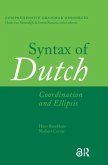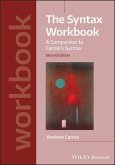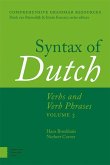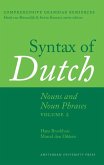Katalin É. Kiss, Veronika HegedusPostpositions and Postpositional Phrases
Syntax of Hungarian
Postpositions and Postpositional Phrases
Herausgeber: É Kiss, Katalin; É Kiss, Katalin; Hegedus, Veronika
Katalin É. Kiss, Veronika HegedusPostpositions and Postpositional Phrases
Syntax of Hungarian
Postpositions and Postpositional Phrases
Herausgeber: É Kiss, Katalin; É Kiss, Katalin; Hegedus, Veronika
- Gebundenes Buch
- Merkliste
- Auf die Merkliste
- Bewerten Bewerten
- Teilen
- Produkt teilen
- Produkterinnerung
- Produkterinnerung
Syntax of Hungarian aims to present a synthesis of the currently available syntactic knowledge of the Hungarian language, rooted in theory but providing highly detailed descriptions, and intended to be of use to researchers, as well as advanced students of language and linguistics.
Andere Kunden interessierten sich auch für
![Syntax of Hungarian Syntax of Hungarian]() Syntax of Hungarian125,99 €
Syntax of Hungarian125,99 €![Syntax of Dutch Syntax of Dutch]() DR. Hans BroekhuisSyntax of Dutch153,99 €
DR. Hans BroekhuisSyntax of Dutch153,99 €![Analyzing Syntax Through Texts Analyzing Syntax Through Texts]() Elly van GelderenAnalyzing Syntax Through Texts40,99 €
Elly van GelderenAnalyzing Syntax Through Texts40,99 €![The Syntax Workbook The Syntax Workbook]() Andrew Carnie (University of Arizona)The Syntax Workbook49,99 €
Andrew Carnie (University of Arizona)The Syntax Workbook49,99 €![Syntax of Dutch Syntax of Dutch]() Hans BroekhuisSyntax of Dutch183,99 €
Hans BroekhuisSyntax of Dutch183,99 €![Syntax of Dutch: Nouns and Noun Phrases - Volume 2 Syntax of Dutch: Nouns and Noun Phrases - Volume 2]() Hans BroekhuisSyntax of Dutch: Nouns and Noun Phrases - Volume 2183,99 €
Hans BroekhuisSyntax of Dutch: Nouns and Noun Phrases - Volume 2183,99 €![Syntax of Dutch: Adjectives and Adjective Phrases Syntax of Dutch: Adjectives and Adjective Phrases]() Hans BroekhuisSyntax of Dutch: Adjectives and Adjective Phrases183,99 €
Hans BroekhuisSyntax of Dutch: Adjectives and Adjective Phrases183,99 €-
-
-
Syntax of Hungarian aims to present a synthesis of the currently available syntactic knowledge of the Hungarian language, rooted in theory but providing highly detailed descriptions, and intended to be of use to researchers, as well as advanced students of language and linguistics.
Produktdetails
- Produktdetails
- Comprehensive Grammar Resources
- Verlag: Amsterdam University Press
- Seitenzahl: 480
- Erscheinungstermin: 10. März 2021
- Englisch
- Abmessung: 240mm x 160mm x 34mm
- Gewicht: 882g
- ISBN-13: 9789463725910
- ISBN-10: 9463725911
- Artikelnr.: 64459802
- Herstellerkennzeichnung
- Libri GmbH
- Europaallee 1
- 36244 Bad Hersfeld
- gpsr@libri.de
- Comprehensive Grammar Resources
- Verlag: Amsterdam University Press
- Seitenzahl: 480
- Erscheinungstermin: 10. März 2021
- Englisch
- Abmessung: 240mm x 160mm x 34mm
- Gewicht: 882g
- ISBN-13: 9789463725910
- ISBN-10: 9463725911
- Artikelnr.: 64459802
- Herstellerkennzeichnung
- Libri GmbH
- Europaallee 1
- 36244 Bad Hersfeld
- gpsr@libri.de
Katalin É. Kiss is research professor at the Research Institute for Linguistics in Budapest, Hungary. Veronika Hegedüs is senior research fellow at the Research Institute for Linguistics in Budapest, Hungary.
General introduction (István Kenesei
General Editor)
1. The series
2. Previous research into the grammar of Hungarian
3. The project
4. The language
5. Acknowledgments
References
Chapter 1 General characteristics and overview (Veronika Hegedüs)
1.1. Introduction
1.2. Basic types and properties of postpositions
1.3. Syntactic uses of postpositions
1.4. Bibliographical notes
Chapter 2 Postpositions: formal and semantic classification (Éva Dékány and Veronika Hegedüs)
2.1. Introduction
2.2. Formal characterization
2.3. Semantic classification
2.4. Where to draw the line: Borderline cases of postpositions
2.5. Bibliographical notes
Chapter 3 The internal syntax of PPs (Veronika Hegedüs and Éva Dékány)
3.1. Introduction
3.2. Complementation
3.3. Modification
3.4. Bibliographical notes
Chapter 4 Predicative PPs (Katalin É. Kiss)
4.1. Introduction
4.2. PPs used as primary predicates
4.3. Telicizing PPs
4.4. Atelic verb modifiers
4.5. The syntax of verb modifiers
4.6. Depictives
4.7. Summary
4.8. Bibliographical notes
Chapter 5 PPs used as arguments (György Rákosi)
5.1. Introduction
5.2. PPs and verbal particles
5.3. Core and non-core PP arguments
5.4. Core and non-core PP arguments of adjectives
5.5. PP complements in noun phrases
5.6. Summary
5.7. Bibliographical notes
Chapter 6 PPs used as obligatory adjuncts (Katalin É. Kiss)
6.1. Introduction
6.2. Definiteness Effect verbs
6.3. Types of internal arguments prohibited by the Definiteness Effect
6.4. Definiteness Effect and aspect
6.5. Neutralizing the Definiteness Effect by a focused adjunct
6.6. Summary
6.7. Bibliographical notes:
Chapter 7 PPs as adjuncts (Barbara Egedi)
7.1. Introduction
7.2. Categorial types and formal properties of adverbial adjuncts
7.3. Semantic types of adverbial adjuncts
7.4. Placement and prosody
7.5. Summary
7.6. Bibliographical notes
Subject index
References.
General Editor)
1. The series
2. Previous research into the grammar of Hungarian
3. The project
4. The language
5. Acknowledgments
References
Chapter 1 General characteristics and overview (Veronika Hegedüs)
1.1. Introduction
1.2. Basic types and properties of postpositions
1.3. Syntactic uses of postpositions
1.4. Bibliographical notes
Chapter 2 Postpositions: formal and semantic classification (Éva Dékány and Veronika Hegedüs)
2.1. Introduction
2.2. Formal characterization
2.3. Semantic classification
2.4. Where to draw the line: Borderline cases of postpositions
2.5. Bibliographical notes
Chapter 3 The internal syntax of PPs (Veronika Hegedüs and Éva Dékány)
3.1. Introduction
3.2. Complementation
3.3. Modification
3.4. Bibliographical notes
Chapter 4 Predicative PPs (Katalin É. Kiss)
4.1. Introduction
4.2. PPs used as primary predicates
4.3. Telicizing PPs
4.4. Atelic verb modifiers
4.5. The syntax of verb modifiers
4.6. Depictives
4.7. Summary
4.8. Bibliographical notes
Chapter 5 PPs used as arguments (György Rákosi)
5.1. Introduction
5.2. PPs and verbal particles
5.3. Core and non-core PP arguments
5.4. Core and non-core PP arguments of adjectives
5.5. PP complements in noun phrases
5.6. Summary
5.7. Bibliographical notes
Chapter 6 PPs used as obligatory adjuncts (Katalin É. Kiss)
6.1. Introduction
6.2. Definiteness Effect verbs
6.3. Types of internal arguments prohibited by the Definiteness Effect
6.4. Definiteness Effect and aspect
6.5. Neutralizing the Definiteness Effect by a focused adjunct
6.6. Summary
6.7. Bibliographical notes:
Chapter 7 PPs as adjuncts (Barbara Egedi)
7.1. Introduction
7.2. Categorial types and formal properties of adverbial adjuncts
7.3. Semantic types of adverbial adjuncts
7.4. Placement and prosody
7.5. Summary
7.6. Bibliographical notes
Subject index
References.
General introduction (István Kenesei
General Editor)
1. The series
2. Previous research into the grammar of Hungarian
3. The project
4. The language
5. Acknowledgments
References
Chapter 1 General characteristics and overview (Veronika Hegedüs)
1.1. Introduction
1.2. Basic types and properties of postpositions
1.3. Syntactic uses of postpositions
1.4. Bibliographical notes
Chapter 2 Postpositions: formal and semantic classification (Éva Dékány and Veronika Hegedüs)
2.1. Introduction
2.2. Formal characterization
2.3. Semantic classification
2.4. Where to draw the line: Borderline cases of postpositions
2.5. Bibliographical notes
Chapter 3 The internal syntax of PPs (Veronika Hegedüs and Éva Dékány)
3.1. Introduction
3.2. Complementation
3.3. Modification
3.4. Bibliographical notes
Chapter 4 Predicative PPs (Katalin É. Kiss)
4.1. Introduction
4.2. PPs used as primary predicates
4.3. Telicizing PPs
4.4. Atelic verb modifiers
4.5. The syntax of verb modifiers
4.6. Depictives
4.7. Summary
4.8. Bibliographical notes
Chapter 5 PPs used as arguments (György Rákosi)
5.1. Introduction
5.2. PPs and verbal particles
5.3. Core and non-core PP arguments
5.4. Core and non-core PP arguments of adjectives
5.5. PP complements in noun phrases
5.6. Summary
5.7. Bibliographical notes
Chapter 6 PPs used as obligatory adjuncts (Katalin É. Kiss)
6.1. Introduction
6.2. Definiteness Effect verbs
6.3. Types of internal arguments prohibited by the Definiteness Effect
6.4. Definiteness Effect and aspect
6.5. Neutralizing the Definiteness Effect by a focused adjunct
6.6. Summary
6.7. Bibliographical notes:
Chapter 7 PPs as adjuncts (Barbara Egedi)
7.1. Introduction
7.2. Categorial types and formal properties of adverbial adjuncts
7.3. Semantic types of adverbial adjuncts
7.4. Placement and prosody
7.5. Summary
7.6. Bibliographical notes
Subject index
References.
General Editor)
1. The series
2. Previous research into the grammar of Hungarian
3. The project
4. The language
5. Acknowledgments
References
Chapter 1 General characteristics and overview (Veronika Hegedüs)
1.1. Introduction
1.2. Basic types and properties of postpositions
1.3. Syntactic uses of postpositions
1.4. Bibliographical notes
Chapter 2 Postpositions: formal and semantic classification (Éva Dékány and Veronika Hegedüs)
2.1. Introduction
2.2. Formal characterization
2.3. Semantic classification
2.4. Where to draw the line: Borderline cases of postpositions
2.5. Bibliographical notes
Chapter 3 The internal syntax of PPs (Veronika Hegedüs and Éva Dékány)
3.1. Introduction
3.2. Complementation
3.3. Modification
3.4. Bibliographical notes
Chapter 4 Predicative PPs (Katalin É. Kiss)
4.1. Introduction
4.2. PPs used as primary predicates
4.3. Telicizing PPs
4.4. Atelic verb modifiers
4.5. The syntax of verb modifiers
4.6. Depictives
4.7. Summary
4.8. Bibliographical notes
Chapter 5 PPs used as arguments (György Rákosi)
5.1. Introduction
5.2. PPs and verbal particles
5.3. Core and non-core PP arguments
5.4. Core and non-core PP arguments of adjectives
5.5. PP complements in noun phrases
5.6. Summary
5.7. Bibliographical notes
Chapter 6 PPs used as obligatory adjuncts (Katalin É. Kiss)
6.1. Introduction
6.2. Definiteness Effect verbs
6.3. Types of internal arguments prohibited by the Definiteness Effect
6.4. Definiteness Effect and aspect
6.5. Neutralizing the Definiteness Effect by a focused adjunct
6.6. Summary
6.7. Bibliographical notes:
Chapter 7 PPs as adjuncts (Barbara Egedi)
7.1. Introduction
7.2. Categorial types and formal properties of adverbial adjuncts
7.3. Semantic types of adverbial adjuncts
7.4. Placement and prosody
7.5. Summary
7.6. Bibliographical notes
Subject index
References.








